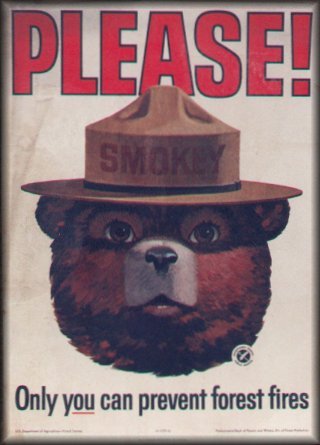Tuesday, May 13, 2008
Sunday, May 11, 2008
Causes of Forest Fires

Causes of Forest Fires
Other causes of Forest Fires:
1. Man’s negligence
- along roadways
- in rural areas
- in wooded areas
- along railway lines
- tourists recreational activities
- fire-cracks, rockets, other explosives
- dumping and burning of illegal wastes
- bad maintenance of electrical lines
- broken or fallen wires
2. Forces of nature
3. Earthquakes (1906 San Francisco earthquake)
4. Sparks from trains or other locomotives
5. Burning and clearing of land
6. Intent on seeking advantages, such as opening new trails
7. Arson
8. Weather (temperature, humidity, precipitation, and wind)
9. Steep slopes offer greater potential for increased fire intensity (making it more difficult to fight the fire)
10. In 2006 83% of forest fires were started by human activities
11. smokers (dropping cigarettes or matches into brush)
Thursday, May 1, 2008
Solutions

- “North American forest management policies and practices over the past 100 years have had the unfortunate consequence of creating conditions that make forest fires burn hotter and with greater severity. During this time, fires have been put out as quickly as possible in order to “protect” timber and private property. The problem is that this allows dead plant matter (dead trees, fallen branches, leaves, small shrubs, brush) to collect on the forest floor, which creates larger and larger “fuel loads”. So instead of small fires that occur frequently, we end up with large fires that create incredible damage.”
Second, there must be a change to how we design our communities.
- More and more people are moving further and further into forested areas, which greatly increase the length of the border between forests and homes. This boundary between forests and human settlement is referred to as the ‘wildland-urban interface’. The ever-increasing size of this interface not only increases the chance of contact with fire, but it dilutes the limited firefighting resources. Firefighters focus on saving houses and families before they work at the source of the fire. This is clearly the right choice, but bringing in more firefighters and water bombers may not be the best way to prevent forest fires from destroying our homes.
Third, there still needs to be a continuation of education on how to prevent man-made fires with a stronger effort to prevent climate change.
- The increase in hot, dry weather is likely the result of global climate change, and it is predicted to get worse. The hot weather dehydrates the fuel on the forest floor, creating perfect conditions for fire. The dryness of the weather also prevents fire dampening from rain.
While there are areas where “thinning” a forest can help, it is a very expensive endeavor. Most of the trees that need to be removed are small in diameter, and have little or no commercial value. Therefore, in order to offset the very high cost of thinning, logging companies are often given the rights to cut the large, old, fire-resistant trees in the forest. This compromises the intent to thin the forest to protect ecosystem values, as this type of logging does not mimic natural patterns, and fire resistant trees are removed. Furthermore, the impact on sensitive soils from machinery used in logging damages the ecosystem. Forest 101 Solutions
Key Terms
Key Terms-Related to Wildfires
- Environmental Sociology
- Environmental Justice
- Global Warming
- Deforestation
- Wildfire Social Inequality
- Loss of Productive Farmland
- Deforestation
- Soil Erosion
- Desertification(desert,dry land)
- Diminish Fertile Land

